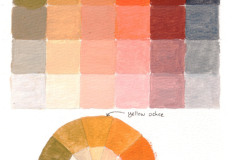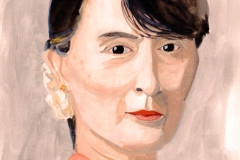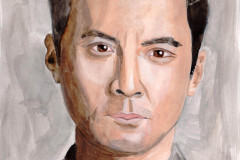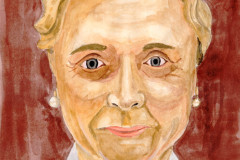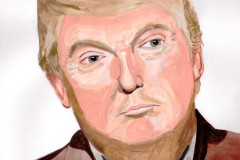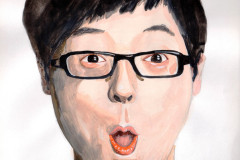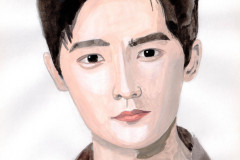Introduction
Gouache painting offers a unique approach to art with its opaque and vibrant finish. This medium blends watercolors’ fluidity with the boldness of acrylics. Understanding gouache’s properties can help you create striking abstract canvas art that stands out. You will learn how to handle gouache effectively to express your creativity.
Exploring abstract canvas designs with gouache allows you to experiment freely with color and form. This article presents practical ideas to inspire your own paintings. It guides you through essential techniques, composition tips, and innovative concepts. Developing your skills with gouache will enable you to produce engaging artworks full of personality.
Understanding Gouache Paint and Its Benefits
Gouache is a type of water-based paint that blends qualities from watercolor and acrylic. It consists of pigment, water, and a binding agent, usually gum arabic. This combination gives gouache its thick, creamy texture and dense coverage. Unlike watercolor, gouache offers full opacity, meaning it hides the surface beneath instead of allowing it to show through. It dries quickly to a matte finish, giving your painting a smooth, even look.
The quick drying time lets you work fast and make changes without waiting long. You can layer colors on top of each other without disturbing the layers below. Gouache also reactivates with water when dry, letting you blend or soften edges if needed. This flexibility works well for abstract art, where bold strokes and spontaneous changes happen often.
Are you ready to try a paint that combines control with freedom? Gouache invites you to experiment with texture, brightness, and layering on your canvas.
Composition and Characteristics of Gouache
Gouache uses strong pigments mixed with a binder called gum arabic, plus additives that help keep the paint smooth and stable. The pigment concentration is higher than in watercolors, which creates its thick feel and opaque coverage. When wet, it applies easily and blends smoothly like watercolor, but once dry, it turns solid and matte, without shine.
This matte finish helps colors look flat and even on the canvas. The paint’s thickness allows you to build layers without colors mixing unless you want them to. Dry gouache can be reactivated with water, so you can modify your work after it dries. These traits set gouache apart from acrylics, which dry hard and stay fixed.
How do you want your colors to behave? The balance between wet and dry phases in gouache opens new paths for your abstract art.
Advantages for Abstract Painting
Gouache supports bold color use and quick changes—perfect for abstract art. Its opacity helps you create sharp contrasts and clear shapes on canvas. You can layer paint confidently, correcting mistakes by painting over unwanted areas. This proves handy when experimenting with shapes and forms.
The fast drying time encourages rapid creative exploration. You can try one idea, let it dry, then add or erase details without waiting hours. This speed supports spontaneous decision-making, essential in abstract work.
Use gouache to mix vivid colors and strong visuals. How might working faster and layering more freely change your creative process? Gouache offers you flexibility and control at the same time, ideal for bold, abstract designs.
Selecting the Right Materials for Gouache Painting
Choosing materials affects the success of your gouache abstract art. Start with the surface. Decide between paper or canvas based on your style and project size.
Prepare your surface by ensuring it is clean and stable. For paper, you might want to stretch it to avoid warping. Plain canvas may need a smooth gesso layer to support gouache’s opaque nature.
Your brushes should fit the techniques you plan to use. Larger flat brushes help cover broad shapes, while fine round brushes offer control for details. Consider both synthetic and natural hair options.
Paint quality matters for colors that stay true and layers that hold well. Beginners can start with student-grade gouache, but professional brands offer stronger pigments and better durability.
Ask yourself what effect you want to achieve. Are you layering thick colors or creating smooth blends? The answers guide your choice of materials and tools.
Choosing Paper or Canvas
Paper and canvas respond differently to gouache. Watercolor paper is designed to absorb moisture, helping you control paint flow and prevent cracking. Rough or cold-pressed textures add interesting patterns to abstract designs.
Canvas offers a sturdier base and can handle heavy paint layers better than paper. Its textured surface may add depth to your abstract creation but can sometimes resist gouache if not primed.
Size matters too. Larger paper sheets or canvases give room for bold abstract gestures. Small surfaces focus your detail work. Consider what scale fits your creative vision and workspace.
Think about how absorbent your surface should be. Do you want quick drying or more time to blend colors? These factors influence whether watercolor paper or canvas suits your painting best.
Brush Types and Paint Quality
Selection of brushes impacts the look and feel of gouache artwork. Synthetic brushes are usually stiffer and hold up better to frequent washing. They work well for sharp edges and controlled strokes.
Natural hair brushes, like sable or hog bristle, offer softer application and better paint flow. They suit artists aiming for smooth blending or gentle textures in abstracts.
High-quality gouache paints contain more pigment, resulting in richer colors and longer-lasting finishes. Low-quality paints may dull over time or require more layers.
Test how each paint brand handles layering and rewetting. Some gouache dries to a matte finish that resists reactivation, which can affect your technique choices.
What brush and paint combinations feel most comfortable for you? Trying a few options may reveal unexpected creative possibilities for your abstract canvas work.
Basic Techniques for Gouache Abstract Art
Layering, blending, dry brushing, and masking form the building blocks of gouache abstract painting. Mastering these techniques lets you control color, texture, and composition on canvas.
Start by applying thin layers of gouache paint, letting each layer dry before adding the next. This approach prevents unwanted mixing and keeps colors vibrant. Try using a flat brush for even coverage and a round brush for detail.
Blending works best while the paint is still wet. You can create smooth gradients by gently moving your brush between two colors. For textured blends, use a stippling or dabbing motion instead.
Dry brushing involves using a nearly dry brush to add scratchy, rough textures. This method reveals canvas texture or underlying layers and adds visual interest. Masking protects chosen areas using masking fluid or tape. Apply these before painting layers to keep parts of your canvas clean.
Each technique offers unique effects. Which one fits your style or project? Experiment on scrap paper or test areas of your canvas to see which methods help express your ideas best.
Layering and Blending Methods
Layering with gouache requires patience. Begin with a light base layer that fully dries before you add the next. Wet paint sets quickly, so avoid overworking a wet surface to keep colors clear and distinct.
Use thin paint mixtures for the first layers to create a smooth foundation. Thicker, more opaque layers on top can add depth. Avoid muddy colors by not mixing different colors on your palette too early.
Blending is easier when your colors are wet. Apply two colors side by side, then quickly smooth the border using a clean, damp brush with gentle strokes. This creates soft gradients perfect for abstract backgrounds.
For textured blending, try brushing with a slightly dry brush that taps or scrapes across the wet paint. This breaks up smooth areas into patterns and marks. Explore how layering and blending can balance a painting’s energy or calmness.
Dry Brushing and Masking
Dry brushing uses a brush with very little paint and moisture to add rough, scratchy effects. Lightly drag your brush across the canvas surface for fine, uneven marks that build texture and interest.
Try dry brushing over dry layers to highlight texture or suggest movement. It works well to emphasize shapes or create subtle patterning in abstract work.
Masking fluid or low-tack painter’s tape blocks paint from reaching certain canvas areas. Apply the mask to dry canvas before painting. When removed, it reveals clean, untouched parts useful for geometric shapes or sharp edges.
Use masking fluid for freeform or irregular shapes, and tape for straight lines. Remember to remove masking only after your paint has dried well to avoid peeling your layers. Masking can help you create contrasts and define your abstract composition smartly.
Creative Abstract Concepts to Inspire Your Work
Abstract art invites you to think beyond representational forms. Geometric patterns offer a structured way to build your composition. Use squares, triangles, or circles as building blocks. Arrange them in repetitive sequences or break them apart for a dynamic feel.
Organic shapes contrast with geometry by adding softness and movement. Imagine shapes inspired by leaves, water ripples, or clouds. Their irregular lines create flow and spontaneity on your canvas.
Color blocking helps you separate areas with bold swaths of color. Choose strong hues to divide the canvas into zones. Gouache’s opacity allows clean edges and rich color intensity ideal for this technique.
Try mixing these concepts. Place organic shapes inside geometric grids. Create color blocks that overlap shapes partially. Experiment to find combinations that give your work energy and balance.
Exploring Shapes and Forms
Use geometric shapes to guide how your eye moves across the canvas. Triangles can point toward focal points. Circles bring softness and unity. Squares add stability. Arrange these shapes to create tension or harmony.
Freeform shapes let you break away from rules. Paint irregular blobs or fluid lines. Overlap them with your geometric shapes to increase complexity. Contrast structured and organic forms to keep your canvas engaging.
Layer shapes using gouache’s fast drying time. Paint one shape, let it dry, then add another partially over it. Adjust opacity by adding water or painting thickly for texture. Think about how shapes interact visually and create balance.
Playing with Color and Contrast
Pick color schemes that support your composition’s mood. High contrast colors like blue and orange activate the eye. Monochromatic schemes invite calm focus. Consider warm or cool palettes based on your message.
Balance bold colors with subtle tones. Use intense pigment for key shapes. Surround these with softer, diluted colors to avoid overwhelming the viewer. This guides attention naturally where you want it.
Try layering colors to build richness. Let some areas show underlying hues through transparent layers. Gouache handles this well when you control water levels. Think about how light and shadow affect your color decisions to add depth.
Developing Your Personal Style with Gouache
Experimenting with gouache helps you find your unique artistic voice. Try blending smooth washes with textured brushstrokes to see how different effects change your canvas. Mix thin layers with thick, opaque areas to create depth. Adjust how much water you use to vary transparency and intensity of color.
Consider revisiting one painting over several sessions. Notice how your vision evolves and what details draw your attention. Let your work grow naturally. Do colors or shapes feel more powerful when altered slightly? Which combinations excite you most?
Your style develops through trial, error, and observation. Push boundaries but keep asking what makes each piece truly yours. What techniques feel authentic? How does your color use tell a story beyond shapes? These questions guide growth over time.
Mixing Traditional and Modern Approaches
Using classic gouache techniques like layering glazes and dry brushing with bold, contemporary abstract forms gives your work fresh energy. Try combining controlled brushwork with spontaneous splatters or irregular shapes. This blend respects traditional painting skills while welcoming freedom.
Understanding foundational rules such as color harmony and composition allows you to break them thoughtfully. How could mixing smooth gradients with sharp geometry alter the mood of a piece? Can you apply old methods in new patterns to surprise yourself and your viewers?
Balance precision with improvisation. When you merge old and new styles, your paintings become more complex and unique. Look for moments where the traditional meets the unexpected.
Refining Color and Composition Choices
Review your gouache paintings objectively. Which colors stand out? Which shapes hold the composition together? Pinpoint areas that feel balanced or chaotic. Write notes about what attracts or distracts you.
Focus on deliberate decisions in your next piece. Select a limited color palette and stick to it. Arrange shapes to lead the eye in a clear path. Avoid random marks by questioning each stroke’s purpose.
Over time, these practices sharpen your style. Your paintings will show clearer intentions and stronger impact. Ask yourself: What color combinations express my ideas best? How can I organize elements to create rhythm and focus?
Common Challenges and How to Overcome Them
Gouache offers vibrant colors and a matte finish, but it also brings specific challenges. One issue you might notice is color shifting after the paint dries. Colors often look different when wet compared to dry, which can affect the final result. You can manage this by testing colors on a scrap piece before applying them to your canvas. Make a note of how each color changes as it dries so you can predict the outcome better. If you want to fix unexpected color shifts, try adding a thin layer of the dried paint with a slightly adjusted hue on top.
Cracking and surface problems can occur if the paint is applied too thickly or dries unevenly. To avoid cracking, apply gouache in thin, even layers and allow each layer to dry completely before adding the next. Maintain a consistent, moderate temperature and avoid drafts while your painting dries. When layering, use gentle brushstrokes and avoid overworking areas repeatedly. These steps help keep your paint flexible and prevent damage to your artwork.
Managing Color Changes After Drying
Color changes happen because gouache paint contains a lot of water that evaporates as it dries. This evaporation dulls colors and can make them appear lighter or different from how they looked when wet. To control this, test your paints on a piece of paper or canvas beforehand. Watch how the color dries and note the shift.
If your colors dry lighter than expected, try mixing in a bit more pigment or a deeper shade when painting. Another way to keep colors vibrant is to layer instead of applying thick coats. Layering lets you build up color gradually without surprises. Consider also the surface you use, since some absorb paint differently, affecting how dry colors appear.
Preventing Paint Cracks and Surface Issues
Paint cracks often happen when gouache dries very fast, or layers are too thick. Avoid putting on heavy coats all at once. Thin, smooth layers dry more evenly and stay flexible. If you notice cracking starting, stop working in that area and let it fully dry before continuing.
Make sure your workspace has steady, moderate humidity and temperature. Dry, hot air speeds evaporation and can cause the paint to crack. You should also handle the canvas carefully, especially when the paint is still drying. Avoid excessive brushing over the same spot, as this can break down the paint film and lead to surface issues. Proper layering and drying will help you keep your abstract creations clear and intact.
Showcasing and Preserving Your Gouache Artworks
Gouache paintings on canvas require special care to keep their vivid colors and texture. Apply a clear varnish designed for gouache if you want extra protection. Some varnishes can dull the matte finish, so test on a small area before covering the whole painting. Choose removable spray varnishes over brush-on types to avoid disturbing the paint surface.
Framing your gouache work protects it from dust and accidental damage. Use acid-free mats and backing board to prevent chemical damage over time. Avoid direct contact between the glass and paint by using a spacer inside the frame. This keeps moisture from accumulating and damaging the paint.
Where you hang your gouache piece matters. Place it away from direct sunlight and areas with high humidity. These conditions speed up fading and can cause paint to swell or crack. Consider rotating displayed artworks to give each piece a rest from light exposure.
Regularly dust your framed canvas with a soft brush or dry microfiber cloth. Avoid damp cloths or sprays that could seep under the glass and harm the paint. How often do you check your paintings? A quick monthly inspection helps catch early signs of damage.
Varnishing and Framing Techniques
Using a spray varnish formulated for gouache offers a protective, even layer without disturbing brushstrokes. Matte varnishes maintain gouache’s signature soft finish, while gloss varnishes can enrich color depth but change the look. Always apply varnish in thin layers and allow each to dry fully.
Frames need to protect your painting but also keep it safe. Opt for deep or gallery frames that create space between the glass and paint. Clamp or secure the canvas carefully, so it doesn’t shift inside the frame. This prevents cracks and dents during display or transport.
Do you know how your frame material reacts to moisture? Wood frames can absorb humidity, affecting the painting inside. Metal or sealed frames might offer better protection in humid spaces. Choose your frame type based on where your art will live.
Storing and Caring for Your Paintings
Store your gouache paintings in a cool, dry place with stable temperature and humidity. Avoid basements or attics where moisture and heat can rise. Wrap unframed canvases in acid-free paper or breathable fabric to prevent dust and physical damage.
Keep paintings upright or flat with padding to avoid warping. Avoid stacking gouache paintings on top of each other, which can cause smudging or paint transfer. Use foam board separators if stacking is necessary for space.
Inspect your stored artworks every few months. Look for signs of mold, color changes, or canvas deterioration. Gently clean your canvas edges with a dry brush if dust accumulates. Caring for your paintings regularly extends their life and keeps colors crisp over years.
Inspiring Resources and Next Steps to Advance Your Gouache Skills
Building your gouache skills takes more than practice. You need fresh ideas and expert guidance to grow.
Books like “The Gouache Studio” by Melissa McClain offer focused techniques and inspiring projects. Consider “Mastering Gouache” by Tom Sheerer for deeper insights on layering and color mixing.
Online tutorials provide step-by-step help. Platforms like Creativebug and Skillshare offer video classes that show brushwork and blending in action. Watching professionals create can sharpen your own approach.
Workshops, both local and virtual, let you experiment and ask questions directly. These sessions often reveal shortcuts and new tricks you won’t find in books.
Keep asking yourself: Which technique challenges your style? How can blending abstract forms push your creativity further?
Finding Educational Content and Tutorials
Focus on content that matches your current skill level but pushes you to improve. Search YouTube channels like Lachri Fine Art or Shibasaki Studio for clear, advanced gouache demonstrations.
Interactive classes on platforms like Domestika allow you to submit your work and get personalized feedback. This direct interaction can speed up your learning curve.
Try courses that highlight abstract gouache techniques specifically, such as layering transparency or texture creation. Test different sources until you find instructors whose style matches what you want to learn.
Ask yourself: What specific skill can I learn today that will impact my next painting?
Connecting with Art Communities
Joining groups on Facebook, Reddit, or Instagram communities focused on gouache connects you with artists worldwide. Feedback from others can reveal strengths and blind spots in your work.
Sharing your progress encourages accountability and sparks new ideas from different perspectives. Collaboration projects or challenges push you out of your comfort zone.
Art communities also offer motivation when your inspiration dips. Seeing others’ interpretations of abstract concepts might inspire your next canvas.
Think about this: How can exchanging ideas with others help you grow faster than practicing alone?
Conclusions
Gouache painting opens many possibilities for abstract canvas artworks. Its versatility lets you experiment with layering, texture, and opacity. Using the ideas and methods shared here, you can refine your artistic expression and discover new effects. Consistent practice helps improve your control over the medium.
Keep exploring different styles and approaches to find what works best for your vision. Your creativity will grow as you push boundaries with gouache paint. Embrace challenges as chances to develop your skills and create meaningful abstract art. Your unique canvas creations will reflect your artistic journey.


















